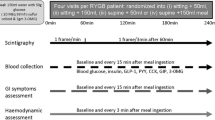Abstract
The bioavailability of dipyridamole, a poorly soluble weak base, was evaluated in 11 healthy, older subjects (≥65 years), 6 with a low fasting gastric pH (control) and 5 with a fasting gastric pH > 5 (achlorhydric), in a randomized, crossover design. Subjects received 50 mg dipyridamole as a single oral dose both with and without pretreatment with 40 mg famotidine (control subjects) or 1360 mg glutamic acid HC1 (achlorhydric subjects). Gastric pH was monitored by Heidelberg radiotelemetric capsule. Gastric emptying of 99mTc-radiolabeled orange juice was measured. Gastric pH appeared to be a primary determinant in dipyridamole absorption in the elderly. Elevated gastric pH resulted in compromised dipyridamole absorption compared to low-gastric pH conditions in all cases. The administration of glutamic acid hydrochloride to achlorhydric subjects prior to the dose of dipyridamole corrected for the decreased C max and AUC(0–36) exhibited in achlorhydric subjects without pretreatment. Tmax and k a were slower in achlorhydrics, although pretreatment with glutamic acid HC1 tended to normalize these parameters. Based on these results, it would be beneficial for achlorhydrics to take glutamic acid hydrochloride prior to taking dipyridamole and other medications which need a low gastric pH for complete absorption. The administration of 40 mg famotidine was successful in elevating the gastric pH to >5 in all subjects and maintained it at >5 for at least 3 hr in all subjects tested. The lack of differences in C max and AUC(0–36) with significant differences in T max and k a indicated that control subjects after treatment with famotidine may serve as an adequate model for achlorhydrics with respect to the extent of absorption, but not with respect to the rate of absorption. Gastric emptying of a nutrient liquid was significantly slower in achlorhydric subjects than in control subjects. Finally, fasting serum gastrin appeared to be a relatively reliable and easy method for screening for achlorhydria in the elderly.
Similar content being viewed by others
REFERENCES
T. L. Russell, R. R. Berardi, J. L. Barnett, L. C. Dermentzoglou, K. M. Jarvenpaa, S. P. Schmaltz, and J. B. Dressman. Upper gastrointestinal pH in seventy-nine healthy, elderly, North American men and women. Pharm. Res. 10 (2):187–196 (1993).
W. T. Davies and J. R. Kirkpatrick. Gastric emptying in atrophic gastritis and carcinoma of the stomach. Scand. J. Gastroenterol. 6:297 (1971).
J. S. Fordtran and J. H. Walsh. Gastric acid secretion rate and buffer content of the stomach after eating. J. Clin. Invest. 52:645–657 (1973).
USP-DI Drug Information for the Health Care Professional, United States Pharmacopeial Convention, Inc., Rockville, MD, 1991, pp. 1171–1173.
Facts and Comparisons, J. B. Lippincott, St. Louis, MO, 1990, pp. 85a–85b.
W. O. Foye. Principles of Medicinal Chemistry, Lea and Febiger, Philadelphia, 1981.
L. C. Dermentzoglou. Changes in Upper Gastrointestinal pH with Aging: Implications for Drug Absorption, Doctoral thesis, University of Michigan, Ann Arbor, 1989.
J. B. Dressman, R. R. Berardi, L. C. Dermentzoglou, T. L. Russell, S. P. Schmaltz, J. L. Barnett, and K. M. Jarvenpaa. Upper gastrointestinal (GI) pH in young, healthy men and women. Pharm. Res. 7 (7):756–761 (1990).
M. J. Knapp, R. R. Berardi, J. B. Dressman, J. M. Rider, and P. L. Carver. Modification of gastric pH with oral glutamic acid hydrochloride. Clin. Pharm. 10:866–870 (1991).
K. M. Wolfram and T. D. Bjornsson. High-performance liquid chromatographic analysis of dipyridamole in plasma and whole blood. J. Chromatogr. 183:57–64 (1980).
J. G. Wagner and E. Nelson. Percent absorbed time plots derived from blood level and/or urinary excretion data. J. Pharm. Sci. 52:610–611 (1963).
J. G. Wagner, D. A. Ganes, K. K. Midha, I. Gonzalez-Younes, J. C. Sackellares, L. D. Olsen, M. B. Affrime, and J. E. Patrick. Stepwise determination of multicompartment disposition and absorption parameters from extravascular concentration-time data. Application to mesoridazine, flurbiprofen, flunarizine, labetalol, digoxin and diazepam. J. Pharmacokin. Biopharm. 19 (4):413–455 (1991).
J. C. K. Loo and S. Riegelman. New method for calculating the intrinsic absorption rate of drugs. J. Pharm. Sci. 57 (6):918–927 (1968).
J. G. Wagner. Pharmacokinetic absorption plots from oral data alone or oral/intravenous data and an exact Loo-Riegelman equation. J. Pharm. Sci. 72 (7):838–842 (1983).
J. H. Proost. Wagner's exact Loo-Riegelman equation: The need for a criterion to choose between the linear and logarithmic trapezoidal rule. J. Pharm. Sci. 74 (7):793–794 (1985).
J. L. Fleiss. The crossover study. In The Design and Analysis of Clinical Experiments, John Wiley and Sons, New York, 1986, pp. 263–290.
N. Kohri, N. Miyata, M. Takahashi, H. Endo, K. Iseki, K. Miyazaki, S. Takechi, and A. Nomura. Evaluation of pH-independent sustained-release granules of dipyridamole by using gastric-acidity-controlled rabbits and human subjects. Int. J. Pharm. 81:49–58 (1992).
P. Lelawongs, J. A. Barone, J. L. Colaizzi, A. T. M. Hsuan, W. Mechlinski, R. Legendre, and J. Guarnieri. Effect of food and gastric acidity on absorption of orally administered ketoconazole. Clin. Pharm. 7:228–235 (1988).
R. R. Recker. Calcium absorption and achlorhydria. N. Engl. J. Med. 313 (2):70–73 (1985).
Author information
Authors and Affiliations
Rights and permissions
About this article
Cite this article
Russell, T.L., Berardi, R.R., Barnett, J.L. et al. pH-Related Changes in the Absorption of Dipyridamole in the Elderly. Pharm Res 11, 136–143 (1994). https://doi.org/10.1023/A:1018918316253
Issue Date:
DOI: https://doi.org/10.1023/A:1018918316253




